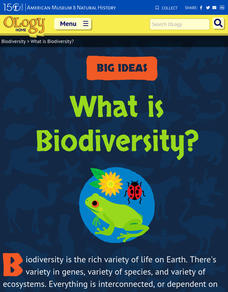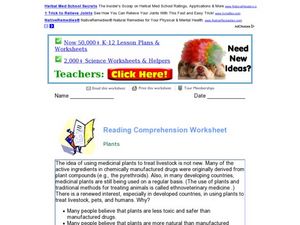Curated OER
Learning About Animal Shelters for Earth Day
Young scholars explore habitats. in this ecology and animal habitat lesson, students listen to the book A House is a House for Me by Mary Ann Hoberman. Young scholars discuss the basic needs of animals and go on a nature walk to observe...
Curated OER
Deserts
What is it like in the desert? Inform your class on what makes a desert, the type of climate they'll find there, and the interesting plant and animals that live in the desert environment. This is a text-rich presentation that will...
American Museum of Natural History
A Closer Look at Mars
A website looks at how we know so much about Mars—telescopes, robots, and spacecraft—and the search for martian life. Following the informational text are three questions that quiz pupils about possible life on Mars.
Curated OER
Z for Zebra
In this zebra facts worksheet, 2nd graders read several short, informational passages about zebras. Students learn facts and read a poem about animals.
Curated OER
G for Giraffe
For this giraffe information worksheet, students read several short, informational passages about giraffes. Students learn facts and read a poem about giraffes.
Curated OER
H for Hippo
In this hippo facts worksheet, students read several short, informational passages about hippos. Students learn facts and read a poem about the animal.
Curated OER
J for Jellyfish
For this jellyfish facts worksheet, 2nd graders read several short, informational passages about jellyfish. Students learn facts and read a short poem about jellyfish.
Curated OER
M for Monkey
In this monkey facts worksheet, 2nd graders read several short, informational passages about monkeys. Students learn facts and read a short poem about monkeys.
Curated OER
L for Lion
In this lion facts worksheet, 2nd graders read several short, informational passages about lions. Students learn facts and read a short poem about the animal.
US Mint
Desert Dwellers
What can a quarter possibly teach young learners about desert ecosystems? More than you might think. After displaying and discussing the included picture of the Arizona state quarter, the class participates in a series of shared reading...
Scholasic
The Magic School Bus and the Missing Tooth
We chew with our teeth every day, but how much do we really know about them? Allow Ms. Frizzle to teach your kids a thing or two about teeth. Kids complete a prereading exercise, read the book, and respond to several prompts about the...
National Wildlife Federation
What's Your Habitat?
How are third graders like rabbits? They both live in habitats and require food, water, and shelter to survive! An educational science instructional activity encourages your learners to think about their own habitats and survival needs,...
Baylor College
A Place to Be
Home sweet home. Humans, birds, beavers, ants, we all need a place place to rest and keep us safe. In the ninth lesson plan of this series, the importance of shelter is discussed as the teacher reads aloud the book Tillena Lou's Day in...
Curated OER
Australian Aboriginal Art and Storytelling
Young explorers investigate Australian Aboriginal culture by listening to traditional Dreamtime stories and examining dot paintings created by Aboriginal artists. In addition, they locate the country on maps, discuss the geography of...
McGraw Hill
Arthropods
Are spiders related to crabs? Study the order of arthropods with a reading selection about animal diversity. It provides details about each class within the order, as well as vivid pictures and explanatory charts.
ReadWriteThink
Teaching Point of View With Two Bad Ants
What better way to explain the concept of point of view than from an ant's perspective! After reading Two Bad Ants, pupils identify the point of view of the ants by studying the text and pictures. Then, they fill out a chart that...
Baylor College
Needs of Living Things: Post-Assessment
Assess your class's knowledge of the needs of living things with the final instructional activity in a series. Given a large piece of paper and coloring utensils, young scientists draw a picture of themselves and a plant or animal of...
K12 Reader
Push and Pull
For this comprehension exercise, kids read a physical science article about forces that can move an object, and then answer a series of questions about the passage.
American Museum of Natural History
What is Biodiversity?
Not all dogs are the same just like not all finches are the same. An interactive online lesson helps individuals learn about the causes and limitations to biodiversity. The clickable sections describe the basics of the genetics of...
K12 Reader
Hide and Seek
After examining a brief article about survival adaptations, readers identify the main idea of the passage and list two supporting details.
K12 Reader
Taiga Ecosystems
After reading a short article about taiga ecosystems, middle schoolers are asked to identify the characteristics of this chilly environment.
Curated OER
Reading Comprehension Worksheet: Plants
In this reading comprehension about plants worksheet, students study an informative text about the medicinal use of plants. Students answer 4 short answer questions.
Alabama Learning Exchange
Nocturnal Animals Lesson #4: Owls
Students investigate the owl food chain. They discuss owl facts, explore various websites, dissect an owl pellet, create a picture of the owl food chain, read the book, "Owl Babies," and write an owl poem.
Curated OER
S for Seal
In this seal information worksheet, students read several informational passages about seals. Students learn facts about the animals and read a poem.

























